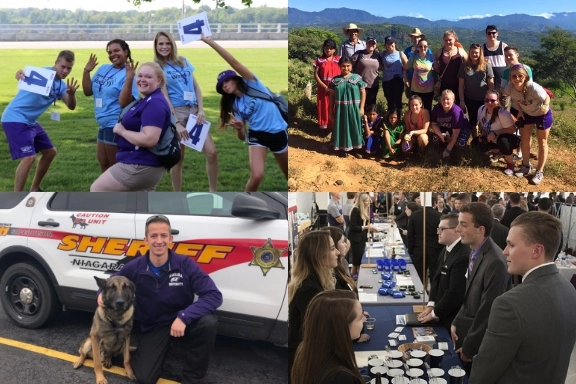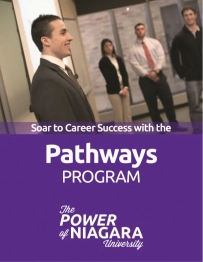What is Pathways?

The Pathways program is a holistic approach to career and professional development that builds confidence through experiential learning, resume preparation, mock interviewing, internship placement and more. By working closely with advisors in the Office of Career Services, students learn to connect their unique skills to their postgraduate goals – and then attain clarity of direction for how to reach them.
Pathways also leverages university resources and alumni connections to prepare students to develop the professional competencies and heightened sense of purpose needed to compete in a hypercompetitive, global economy.
College is a time of self-discovery and exploration. Ideally, students begin the Pathways process during freshman year; however, the program is flexible and customizable to meet students wherever they are in their own development process. Below are details of the 4-step process.
Assess Yourself
Clarify your interests, skills, abilities, and values
- Meet with a career advisor to create a personalized career development plan
- Begin to clarify your career interests through courses, student organizations, and project-based learning through service (visit the IMPACT Office).
- Choose your initial major and/or concentration and learn about your potential career paths.
- Still deciding on a major? Check out the Academic Exploration Program
- Meet with a Career Services advisor to begin compiling interests, strengths, skills, abilities and values using self-assessment inventories available such as the Strong Interest Inventory, Self-Directed Search, My Plan and Myers Briggs Type Indicator.
- Claim your account on the Get Hired Portal powered by Handshake
- Obtain a part-time and/or summer job to develop interpersonal skills, help finance your education, and build responsible work habits.
- Create a draft resume with the help of Career Services
The Strong Interest Inventory (SII) is a psychological test used in career assessment. It is also frequently used for educational guidance as one of the most popular personality assessment tools. The test was developed in 1927 by psychologist E.K. Strong, Jr. to help people exiting the military find suitable jobs. It was revised later by Jo-Ida Hansen, and David Campbell. The modern version is based on the typology (Holland Codes) of psychologist John L. Holland. The newly revised inventory consists of 291 items, each of which asks you to indicate your preference from five responses.
The test can typically be taken in 25 minutes after which the results must be scored by computer. It is then possible to show how certain interests compare with the interests of people successfully employed in specific occupations. Access to the comparison database and interpretation of the results usually incurs a fee. We here at Niagara University will give you the exam through our office.
Strong Interest Inventory is a registered trademark of CPP, Inc. of Mountain View, California.
The Myers-Briggs Type Indicator (MBTI) assessment is a psychometric questionnaire designed to measure psychological preferences in how people perceive the world and make decisions. The original developers of the personality inventory were Katharine Cook Briggs and her daughter, Isabel Briggs Myers. They began creating the indicator during World War II, believing that a knowledge of personality preferences would help women who were entering the industrial workforce for the first time identify the sort of war-time jobs where they would be “most comfortable and effective. The initial questionnaire grew into the Myers-Briggs Type Indicator, which was first published in 1962. The MBTI focuses on normal populations and emphasizes the value of naturally occurring differences.
The MBTI instrument is called “the best-known and most trusted personality assessment tool available today” by its publisher, CPP (formerly Consulting Psychologists Press). CPP further calls the MBTI tool “the world’s most widely used personality assessment”, with as many as two million assessments administered annually. Proponents of the test, however, cite unblinded anecdotal predictions of individual behavior, and claim that the indicator has been found to meet or exceed the reliability of other psychological instruments.
Discover the Possibilities
Explore and research potential career options. Identify the connections between coursework and experiential learning opportunities.
- Research careers related to your major choice.
- Identify skills gaps and create a plan to develop the necessary skills for success
- Learn how to network with alumni, parents, and employers
- Gain access to the Alumni Career Network
- Conduct Informational interviews with employers, alumni, relatives, and family friends
- Explore opportunities to gain relevant work experience through internships, research, summers jobs, and volunteer experience
- Utilize work experience to further develop work-related skills and improve self-confidence.
Gain Experience
Use your increased self-awareness to revise your career plan and apply for experiential learning opportunities.
- Learn how to tell your story effectively using a resume, cover letter and social networking
- Participate in a practice interview to begin articulating what you have learned from your academic and experiential learning opportunities
- Explore and apply for internship opportunities
- Seek leadership opportunities in campus organizations related to your major
- Network and join professional organizations and community groups
- Investigate the role of graduate school in your chosen career field by visiting Petersons and Grad schools as well as discussing with your academic advisor
Implement Your Plan
Define your post-graduation goals and put your plan in action.
- Meet with Career Services to discuss graduate school and/or job search strategies.
- Understand what employers and graduate/ professional schools are looking for in candidates and be able to discuss how your knowledge, skills and abilities will be an asset to their organization.
- Attend career fairs to network with job recruiters.
- Continue to update your resumes and cover letters.
- Analyze job/offers/graduate school admissions and weigh your options
- Join the Niagara University Alumni Group on LinkedIn
- Learn how to accept, decline and negotiate offers to Get Hired!

